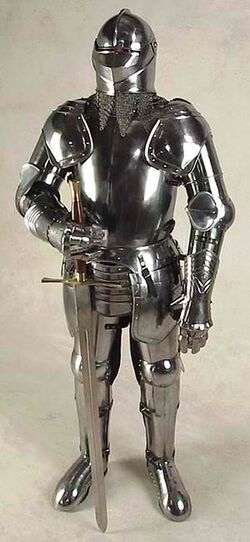Plate armor
Plate Armor is, simply put, armor made of solid plates of metal, essentially a slab of metal made to be worn by people. The cumbersomeness and the lack of mobility is often exaggerated in media, mostly due to confusing tourney armor with combat armor. Tourney armor indeed was unreasonably heavy, thick and restricting in movement, precisely because no one wanted to die or just break a rib (which considering the shitty medicine of that days could be fatal as well) on a tourney, but when knights and men at arms and t war, they clad themselves in a much lighter combat armor, in which they could run, jump, or even perform a somersault almost as easily as in in a chain mail - because in a real fight you should fight for hours rather than few minutes, and mobility is just as important as armor for survivability.
A decent plate armored suit could deflect or shatter most blades and arrows that struck it due to its hardiness, requiring those who wielded these weapons to either find chinks in the armor to stab at the wearer (which is a bit hard when he's trying to chop your head off with impunity), or use concussive/heavy piercing weapons like maces and warhammers, which could either bypass or penetrate the plating. Arrows had limited effect as well, although bolts shot from crossbows typically had enough power to at least dent plate armor, and heavy crossbows could plow through it with ease. Contrary to popular beliefs guns didn't pierce through plate with ease - only high-caliber muskets had enough power in their shot to reliably pierce though the plate, and much like heavy crossbows they payed for it with their sluggishly slow firing rate. From the times of sword and shot also originate the term "bullet-proof", as when a noble or a mercenary went to buy a new set of armor (or just a plate cuirass), he got a pistol with him, and "proofed" his buy by shooting at it at point-blank - good armor suit were supposed to hold that shot, and good luck selling anyone a suit which hadn't passed the test, because who the fuck gonna buy and armor that couldn't stop a pistol in a times when everyone and his dog is armed with one.
In fantasy, plate armor is typically given to warrior classes to denote their position as the front-line close combat fighters. Its commonly also the victim of Fantasy Armor syndrome where the armor is so bulky beyond belief that you start to wonder how the wearer is able to move, much less fight, when the armor is twice as big and heavy as him.
Parts of Plate Armor

- Plate helmet (many variants existed, although they're all designed to protect the head)
- Visor (Covered the face. Was usually hinged with the helmet, although some people did not bother with visors)
- Gorget (covers the neck)
- Spaulders (covers the shoulders)
- Pauldrons (an evolution of the spaulders. Pauldrons are larger than spaulders, not only covering the shoulder, but most of the upper arm as well. They're also reliable as blunt implements to shoulder charge somebody with.)
- Rerebraces (covers the upper arms)
- Couter (covers the elbows)
- Vambraces (covers the forearms)
- Gauntlets (covers the hands)
- Curiass (plate which covers the torso)
- Breastplate (single plate which covers the front of the torso)
- Backplate (covers the back of the torso)
- Tassets (covers the upper legs. They're the plate skirt that covered the cuisse)
- Cuisses (covers the thighs)
- Poleyn (covers the knees)
- Greaves (covers the lower legs)
- Sabatons (boots for walking and covers the feet)
Plate armor by region
- Ancient Greece
- Medieval Europe
- Japan